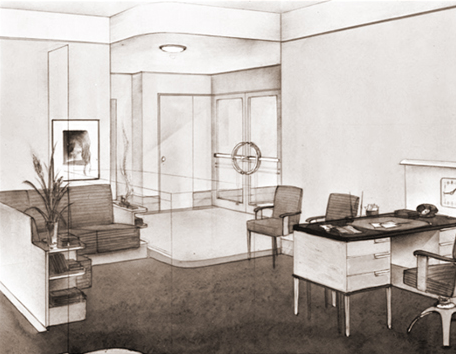The museum’s fifth gallery is billed as “We Were in a New Business.” It’s a phrase Walt used to describe the new reality his company entered into upon the astounding box office success of Snow White and the Seven Dwarfs (1937). Undoubtedly, a significant symbol of this reality was the new studio Walt built. For May’s Spotlight Talks, our Museum Educators illuminated our guests to the story behind this special facility.
Until the late 30s, The Walt Disney Studios called Los Angeles’ Silver Lake District its home. Starting in 1927, artists created animated shorts depicting Oswald the Lucky Rabbit, Mickey Mouse, and many beloved characters of the Silly Symphonies series from a collection of structures on Hyperion Avenue. But as the business grew, the workplace struggled to keep up. Rooms were added onto existing buildings and drawing boards were set up in nearly any available space. Even whole production units were moved offsite, as was the case with Bambi (1942) when its artists set up shop in Hollywood.

The revenue from Snow White and the Seven Dwarfs enabled work to begin on a new facility, one in which all employees could be housed on the same lot comfortably. For the site of their business’ new home, Walt and Roy chose fifty-one acres along Buena Vista Street in nearby Burbank, about seven miles northwest from the Hyperion facility.
Walt planned the new studio facility in consultation with his brother Roy, his long-time technical advisor Bill Garity, and his studio architect/contractor Frank Crowhurst. To help create the new studio, Walt partnered with the famed architect and designer Kem Weber. Details, from the size of the windows to the shape of the desks, were carefully crafted to place the needs of the employees first. Buildings were constructed for specific parts of the filmmaking process and underground tunnels optimized efficiency.
The staff began moving into the new Studio over the holidays between December 1939 and January 1940. The last building (the Sound Transfer Building) was completed and occupied in October 1940. Climate controlled environments brought relief to artists who had previously sweltered in the summertime heat of the Hyperion studio. Other amenities, like an onsite restaurant and plentiful lawn areas, made life enjoyable. On the rooftop of the animation building was the Penthouse Club, in which members could take steam baths, exercise in a gym under the watchful eye of a trainer, or enjoy the soda fountain.
Although it was state of the art, the new studio unwittingly signaled a change from a family, small business-like atmosphere to that of a corporate enterprise. Various departments were compartmentalized and the ranks of employees swelled with new arrivals. This transition was not an easy one and it was made all the more difficult by World War II. Then the postwar period ushered in a new chapter at the studio, marked by more than just animated features. Live-action films and television shows soon became part of Disney’s repertoire. Projects like 20,000 Leagues Under the Sea (1954) and Mickey Mouse Club made frequent use of the (at the time) four soundstages.
Overall, many of Walt’s values were reflected in the studio. His consistent embrace of innovation made this studio a facility that was ahead of its time. In addition, Walt’s belief in diversification was reflected in the kinds of entertainment produced there. In the end, the studio visualized and reinforced Walt’s conviction that his team was truly “in a new business.”
Jeffrey Moffit Museum Content Specialist